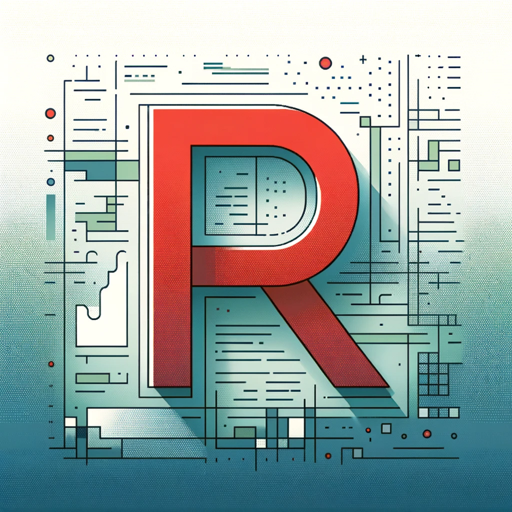Racket Programming Assistant-AI Racket programming support tool
AI-powered assistance for Racket developers
Explain Racket's syntax
Debug my Racket code
Racket language best practices
Convert this code to Racket
Related Tools
Load More
R Wizard
A specialist in R programming, skilled in Data Science, Statistics, and Finance, providing accurate and useful guidance.

R Language Assistant
Assists with R language coding

Rust Assistant
Your go-to expert in the Rust ecosystem, specializing in precise code interpretation, up-to-date crate version checking, and in-depth source code analysis. I offer accurate, context-aware insights for all your Rust programming questions.

Racket Expert
Explains racket code details on request

R Buddy
Concise R code solutions with minimal explanations

R Programmer
Expert in R programming, assisting with advanced code solutions and explanations.
20.0 / 5 (200 votes)
Introduction to Racket Programming Assistant
The Racket Programming Assistant is designed to assist users in exploring, learning, and working with the Racket programming language. Its primary purpose is to offer context-aware, detailed responses tailored to Racket-related queries, such as syntax clarification, debugging advice, or help with Racket's functional and modular design paradigms. It is built to help users better navigate Racket’s features like macros, modules, contracts, and its powerful Lisp-based foundation. By referencing official Racket documentation, the assistant ensures accuracy and thoroughness, facilitating an improved learning experience. For instance, in a scenario where a user is struggling with Racket’s syntax for creating custom macros, the assistant can provide not only the correct syntax but also a detailed explanation of how macros work, common pitfalls, and best practices. In another case, a user working on web development with Racket's 'racket-web-server' might receive guidance on setting up routing or creating dynamic content pages. Overall, the assistant’s functionality is centered on enhancing productivity and deepening understanding of Racket.

Main Functions of the Racket Programming Assistant
Syntax and Error Resolution
Example
A user receives an error related to unbound identifiers or function application mismatch. The assistant analyzes the error message, explains the problem in detail, and provides the correct syntax or logic.
Scenario
A developer is writing a recursive function in Racket but receives an 'unbound identifier' error due to improper scope. The assistant not only points out the incorrect scope but also walks through how scope works in Racket and suggests better structuring.
Custom Macro Development
Example
A user is learning to create domain-specific languages using Racket's macros. The assistant explains how to define syntax rules and shows common patterns used in creating macros.
Scenario
An educator is building a simplified language for students using Racket and needs help creating macros that abstract complex programming concepts. The assistant helps in defining hygienic macros that ensure no namespace conflicts, allowing the educator to focus on the teaching aspect rather than debugging macro issues.
Racket Ecosystem Navigation
Example
The assistant helps a user navigate Racket libraries (such as web-server or math libraries) by identifying appropriate packages, explaining usage patterns, and offering links to relevant documentation.
Scenario
A startup uses Racket for a web application and needs to integrate an external library for generating PDF reports. The assistant guides them on installing the 'pict' library, shows example usage, and offers documentation links for further exploration.
Ideal Users of the Racket Programming Assistant
Beginner Programmers Learning Racket
This group consists of people who are new to Racket or programming in general. The assistant provides detailed explanations of concepts such as functional programming, recursion, and macro usage in Racket. Its ability to clarify errors, walk through language fundamentals, and introduce them to Racket's tooling makes it highly beneficial to this user group.
Experienced Developers Utilizing Racket for Advanced Applications
These are experienced developers familiar with other languages but working with Racket for specific purposes, such as macro development, DSL creation, or web application development. The assistant aids by offering advanced insights into Racket's strengths (like macros and modularization) and solutions to complex problems, making it a valuable resource for efficient project development.

Steps to Use Racket Programming Assistant
Step 1
Visit aichatonline.org for a free trial without login, no need for ChatGPT Plus.
Step 2
Once on the platform, enter your specific Racket-related questions or programming challenges into the input field.
Step 3
Ensure you provide as much context as possible for more accurate and detailed responses. Use code snippets or specific problem descriptions.
Step 4
Review the generated answers, which are based on official Racket documentation and are designed to clarify your issues or guide you through Racket projects.
Step 5
Apply the solutions or guidance in your Racket environment and iterate as needed by asking follow-up questions.
Try other advanced and practical GPTs
Colorizer Pro
Bring your photos to life with AI

Hardware Mastermind
AI-powered tool for hardware mastery

Software Mastermind
Build smarter software with AI-driven precision.

E-Commerce Assistant
AI-powered guidance for e-commerce success

Strong Network's Brand GPT
AI-powered content for tech-driven brands

翻译成英文
AI-powered Chinese to English translation tool

MJ V6 Prompt Generator
AI-powered prompt generation for MidJourney.

水彩画家
AI-powered watercolor artistry at your command.

Guide for medical education
AI-powered medical learning made simple

Academic Discussion Post Reply
AI-Powered Academic Discussion Support

Get Her Hired
AI-powered tool for executive resume perfection.

Sketch Artist
AI-powered sketch art creator for everyone

- Debugging
- Performance Optimization
- Project Guidance
- Syntax Help
- Code Explanations
Q&A About Racket Programming Assistant
What is the primary function of the Racket Programming Assistant?
The Racket Programming Assistant helps users by answering detailed questions about Racket programming, providing code explanations, and offering guidance based on official Racket documentation. It supports both beginners and advanced users.
What kind of problems can I solve with the Racket Programming Assistant?
You can solve various Racket-related challenges, such as understanding specific language features, debugging code, optimizing performance, and even getting support for academic or personal projects.
Does the Racket Programming Assistant require a subscription or payment?
No, you can access the Racket Programming Assistant for free by visiting aichatonline.org. There's no need for a ChatGPT Plus subscription or any other paid service.
How accurate are the responses provided by the Racket Programming Assistant?
The responses are based on official Racket documentation, ensuring they are accurate and reliable. However, users are encouraged to clarify their questions for optimal assistance.
Can the Racket Programming Assistant help with large-scale Racket projects?
Yes, it can guide users through complex Racket projects by helping with structure, modularization, debugging, and advanced language features. Detailed inquiries yield the best results.